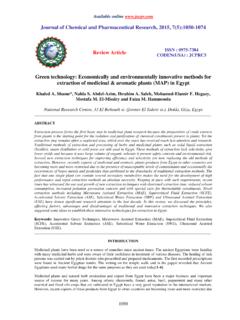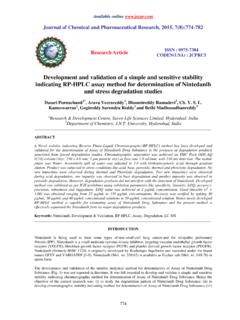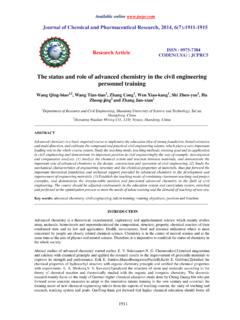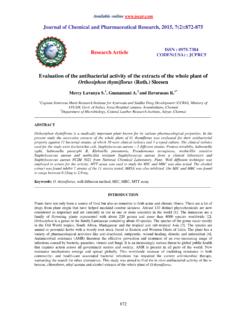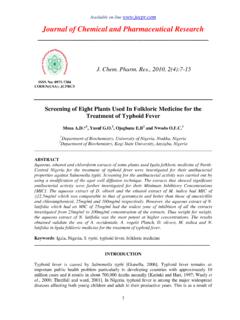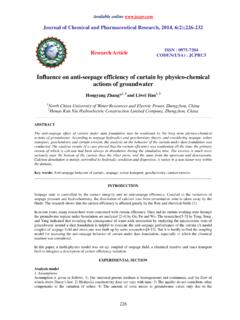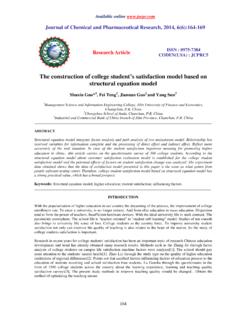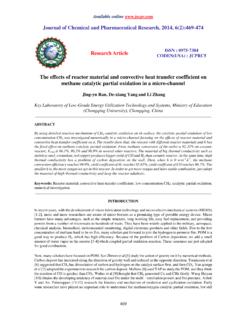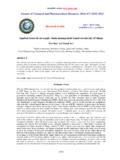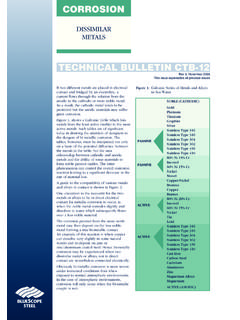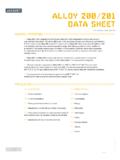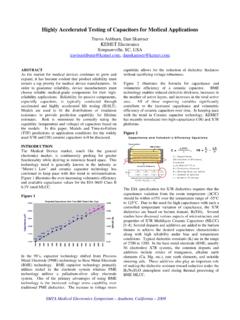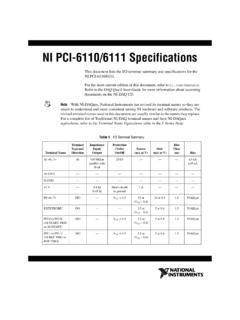Transcription of Journal of Chemical and Pharmaceutical Research, …
1 Available online Journal of Chemical and Pharmaceutical research , 2014 , 6(10):64-73 research Article ISSN : 0975-7384 CODEN(USA) : JCPRC5 64 Nootropic activity of Vigna aconitifolia seeds in presence and absence of cognitive deficit mice model Saeed Makrania, Syed Ayaz *, Khan Subur and Sakle Nikhila aDepartment of Pharmacology, Y. B. Chavan College of Pharmacy, Dr. Rafiq Zakaria Campus, Aurangabad, Maharashtra, India bDepartment of Pharmacognosy, Y. B. Chavan College of Pharmacy, Dr. Rafiq Zakaria Campus, Aurangabad, Maharashtra, India _____ ABSTRACT Dementia or cognitive problems are commonly seen in a large population. The factors such as emotions, stress and age are responsible for memory loss. In traditional system of Ayurvedic medicine, numerous herbs possessing saponins, have been used to treat cognitive disorder.
2 Vigna aconitifolia (Fabaceae) is the rich source of saponins. Two doses (100 and 200 mg/kg., ) of n-butanolic fraction Vigna aconitifolia extract (BVA) were administered for 7 successive days in separate group of animals. Furthermore, on the 7th day scopolamine ( mg/kg., ) administered to as cognitive deficit. The series of established neuropharmacological tests including elevated plus maze and passive avoidance paradigm were studied on 7th and 8th day. Baclofen induced hypothermia and measurement of acetylcholinestrase (AChE) activity were also carried out. BVA significantly improved learning and memory both in absence and presence of cognitive deficit. Also reversed the baclofen induced hypothermia. The mechanism by which BVA exerts nootropic activity was decreased AChE activity inhibition of AChE enzyme and inhibition of GABAB receptor.
3 With the above data, we conclude that Vigna aconitifolia extract shows potent nootropic activity both in absence and presence of cognitive deficit. Key words: Dementia, Vigna aconitifolia, saponins, Scopolamine. _____ INTRODUCTION Memory is ability of an individual to record event, information and retains them over short or long periods of time and recalls the same whenever needed. Age, stress and emotion are conditions that may lead to memory loss or dementia [1]. Dementia is a mental disorder characterized by loss of intellectual ability sufficiently severe as to interfere with one's occupational or social activities. Dementia is of several types and it invariably involves impairment of memory. The most common cause of dementia is Alzheimer's disease, a progressive neurodegenerative disorder associated with loss of neurons in distinct brain area [2].
4 The central cholinergic pathways play a prominent role in learning and memory processes. Loss of cholinergic cells particularly in the basal forebrain, is accompanied by loss of the neurotransmitter acetylcholine. A decrease in acetylcholine in the brain of patients with AD appears to be a critical element in producing dementia [3]. Recently, the mainstay treatments for the dementia are acetylcholinesterase inhibitors which increase the availability of acetylcholine at cholinergic synapses. AChE inhibitors from general Chemical classes such as physostigmine, tacrine and galantamine like drugs have been tested for the symptomatic treatment of AD or dementia. However, Syed Ayaz A. et al J. Chem. Pharm. Res., 2014 , 6(10):64-73 _____ 65 because of certain severe limitations of these drugs like non selectivity, their limited efficacy, poor bioavailability, adverse cholinergic side effects in the periphery, narrow therapeutic ranges and hepatotoxicity are among the severe limitations to their therapeutic success [4].
5 Therefore, in recent years, there has been a phenomenal rise in the interest of scientific community to explore the pharmacological actions or to confirm the veracity of claims made about herbs in the official book of Ayurveda. Nootropics are the agents that enhance memory or cognition. They are drugs, supplements, nutraceuticals, and functional foods that are purported to improve mental functions such as cognition, memory, intelligence, motivation, attention, and concentration [5]. Several medicinal plants claimed to promote learning, memory and intelligence (nootropics). Plants like Hypericum perforatum [6], Albizzia lebbeck [7], Asparagus recemosus [8], Tinospora cordifolia [9], Cissampelos pariera, Panax ginseng as well as Ocimum sanctum [10] have been investigated for their effect on cognitive functions.
6 Saponins from B. monniera, P. ginseng and A. lebbeck are active principles responsible for enhancing cognitive behavior in experimental animals. Since the seeds of Vigna aconitifolia (Fabaceae) are rich in saponins [11]. In the light of above information the present study was undertaken to investigate the effects of n-butanolic fraction of Vigna aconitifolia seeds (BVA) on cognitive functions activity in mice by using models like scopolamine induced amnesia, baclofen induced hypothermia and measurement of AChE activity. EXPERIMENTAL SECTION Collection of Plant materials The seeds of Vigna aconitifolia were collected from the plants in local area near Aurangabad, Maharashtra, India. Sample was authenticated at the Department of Botany, Dr.
7 Babasaheb Ambedkar Marathwada University, Aurangabad (voucher specimen no. 0538). Preparation of plant extracts Isolation of saponins Saponins were isolated from dried seeds of Vigna aconitifolia as described by Pal et al [12]. Coarse powder of shade dried seeds of Vigna aconitifolia were defatted with petroleum ether (60 800C) in Soxhlet s extractor. The marc was dried and again extracted with Ethanol in Soxhlet s extractor. The Ethanolic extract was evaporated to dryness in vacuum. The residue was suspended in water, extracted with ethyl acetate and n-butanol and the solution was evaporated to dryness in vaccum to provide ethyl acetate n-butanol and water soluble portions. The n-butanol soluble fraction was tested for the presence of saponins using haemolysis test and foam test.
8 Experimental Animals Albino mice (20-22 g) of either sex were used in this study. Those animals were allowed to acclimatize to laboratory conditions for 10 days after their arrival. The animals were housed in groups of six under standard housing conditions. Animals were fasted overnight prior to drug administration and during the experiment. All experiments were carried out during the light period (08:00-16:00 h). The experimental protocol was approved by Institutional Animal Ethics Committee (IAEC) of Chavan College of Pharmacy Aurangabad (Approval number- CPCSEA/IAEC/P col -14/2011-12 as per the direction of CPCSEA, under Ministry of Animal Welfare Division, Government of India, New Delhi, India. Drugs preparation and administration Scopolamine (10 mg tablet/tab), baclofen (10 mg tablet/tab) and Piracetam (800 mg tablet/tab) is used as standard drug in this study.)
9 All drugs were dissolved in water. BVA extract was suspended in water by using span 80. Scopolamine, baclofen and piracetam were administered by intraperitoneal route and BVA was administered by oral route. All administered substances including BVA solutions and extract suspension were freshly prepared. Experimental protocol: All animals were randomly assigned to 8 groups (n = 6 in each group). Group I: Vehicle treated (Normal control). Group II: Piracetam treated positive control (200mg/kg). Group III: Scopolamine treated ( ). Group IV: BVA treated (100 mg/kg). Group V: BVA treated (200mg/kg). Syed Ayaz A. et al J. Chem. Pharm. Res., 2014 , 6(10):64-73 _____ 66 Group VI: BVA (100 mg/kg + Scopolamine) treated. Group VII: BVA 200 mg/kg + Scopolamine) treated.
10 Group VIII: (Piracetam 200 mg/kg + Scopolamine) treated. BVA Extract was administered by oral route for 7 days. Behaviors evaluation: The animals were divided into eight groups as mentioned earlier. The behavioral profiles were assessed for nootropic activity. Each animal was subjected to the following behavior task: (a) Elevated plus maze test (b) Passive avoidance paradigm. Elevated plus maze The Elevated plus maze (EPM) test is suggested to be a simple method for the evaluation of learning and memory in mice by measuring transfer latency. EPM served as exteroceptive behavioral model in which stimulus exist outside the body. An elevated plus maze consisting of two open arms (16cm x 5 cm) and two enclosed arms (16cm x 5cm x12 cm) were connected to give the apparatus a plus sign appearance was used.
